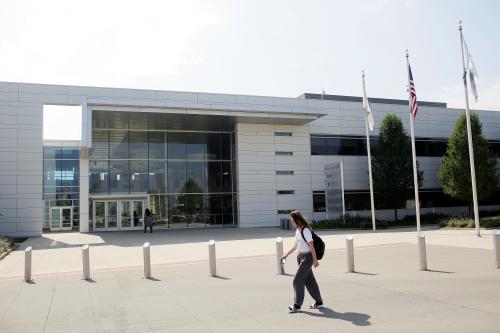If you want more content like this, subscribe to our newsletter.
This week in Class Notes:
-
- The share of American workers in both low- and middle-wage jobs decreased between 1973-2018, while the proportion of high-wage workers increased.
- The Oregon Promise program increased enrollment in in-state community colleges.
- Government expenditures aimed at improving the health and education of low-income children have the highest returns.
- This week’s top chart shows that low- and middle-wage jobs could decline further by 2030.
- Douglas Belkin opines on the role of standardized tests in college admissions.
- An occasional Spotlight section features an essay about Raj Chetty: “The economist who would fix the American Dream”.
- Finally, check out our new piece about how colleges in the Mountain West region help students attain or maintain a middle class standard of living.
Is employment polarization informative about wage inequality and is employment really polarizing?
Are American workers increasingly concentrated in low- and high-wage jobs relative to middle-wage jobs? No, according to Jennifer Hunt and Ryan Nunn. Some studies conclude that computerization and automation have caused occupational polarization by increasing the demand for high-wage workers while displacing middle-wage workers, forcing them into low-paying jobs. In an important new paper, Hunt and Nunn (a Brookings colleague) analyze wage data at the individual level rather than occupational level and find that while the share of middle-wage workers decreased between 1973-2018, so too did the share of low-wage workers. Rather than polarizing, the labor market is creating more jobs for high-wage workers.
What does free community college buy? Early impacts from the Oregon Promise
The Oregon Promise, a program that subsidizes tuition at in-state community colleges, significantly increases enrollment. This is a “final dollar” program: i.e. students receive a Promise grant for any tuition costs not covered by other sources. (Other students whose tuition and fees are covered by alternate sources of aid are provided with up to $1,000 per year). Oded Gurantz uses a difference-in-difference framework to estimate the effect of the Promise grant on community college enrollment in Oregon relative to six control states. In the first year the program was implemented, increased community college enrollment was largely the result of students shifting away from four-year colleges. By the second year, however, students exposed to the program who would have otherwise not gone to college were 4.3 percentage points more likely to enroll at a community college.
A unified welfare analysis of government policies
Government expenditures aimed at low-income children are the most effective at improving social welfare, according to Nathaniel Hendren and Ben Sprung-Keyser. In a comprehensive study, the authors analyzed 133 historical policies such as the Perry School Program, Medicare, and Unemployment Insurance to determine each policy’s Marginal Value of Public Funds (MVPF), drawing on anonymized tax records. The MVPF is the ratio of policy benefits to net government costs. A large MVPF signals high return on investment. In general, government expenditures aimed at improving the health and education of low-income children have higher returns, and these policies actually pay for themselves in the long run. Expenditures on adults typically have lower returns, unless the policies have spillover effects on children.
Top chart
This week’s top chart, from McKinsey shows that current low- and middle-wage jobs could decline by 2030 even as high-wage jobs increase. Automation of tasks in some administrative and production jobs would displace middle-wage workers while high-wage workers such as software developers and nurse practitioners would benefit from an increase in jobs. “This trend will require training and education for a large portion of the workforce” the report concludes. “Forging career pathways to help people move up and finding sources of future middle-wage jobs will be essential to sustaining the U.S. middle class.”

Choice opinion
“As Americans debate the roles of wealth, race and access in higher education, researchers at Georgetown University wondered: What would the nation’s most selective colleges and universities look like if they admitted students solely on the basis of SAT scores? Their answer: The most prestigious U.S. campuses would be wealthier, whiter and more male—leading researchers to question the role standardized testing plays in a fair, comprehensive admissions process,” writes Douglas Belkin in The Wall Street Journal.
Spotlight
This week’s spotlight features an essay about Raj Chetty, “The economist who would fix the American Dream”, published in The Atlantic. Chetty pioneered an approach that uses newly available sources of government data to reveal striking patterns of upward mobility and stagnation in America. In one of his most well-known studies, he finds that the fraction of children who earn more than their parents decreased from 90% for children born in 1940 to 50% for children born in the 1980s.
Self-promotion
In “Making a middle class: Colleges and cities in the Mountain West”, Katherine Guyot and I use a new metric of economic mobility to examine the extent to which colleges are helping students attain or sustain a middle-class standard of living in the Mountain West region. We find that most colleges help middle class students move up the economic ladder, or at least protect them against downward mobility. (And please let us know what you think of our measure – we would like to do more work in this area.)








Commentary
Class Notes: More jobs for high-wage workers, social welfare, and more
Wednesday, August 7, 2019